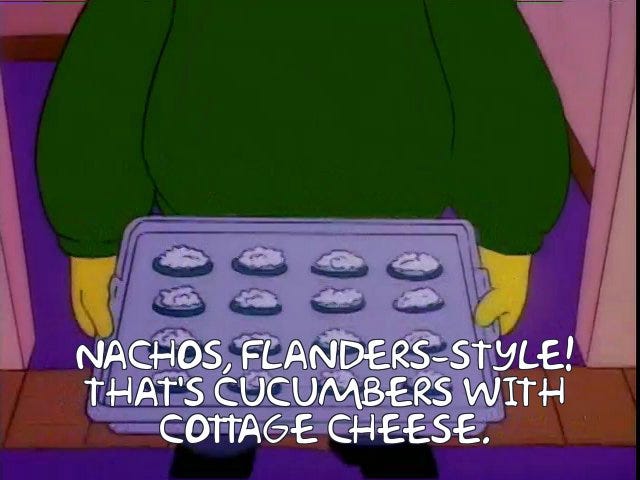The Good and Bad Habits I Learned from Sketch
Lessons that help and hurt you when applied to other forms of writing
This newsletter primarily focuses on sketch because, well, it’s what I know best. I wish I had enough sitcom experience to speak broadly about writing for TV. Maybe (hopefully?) in a few more years? Assuming people keep hiring me? Man, I hope people keep hiring me… [long stare into the middle distance]
But, hey, I can talk a bit about shifting from sketch to narrative comedy. There were times when I felt like my sketch experience helped me and other times when it seemed like a hindrance. Here are a few bad habits from sketch that’ll totally screw you in other forms, and some good habits so you can still feel good about what you’re doing.
Bad Habit: Repetition
Sketches require repetition. It’s the backbone of game, and the source of a sketch’s structure, rhythm, and comedy. You can’t do without it. Unfortunately, repetition is poison to narrative.
Sketches and stories start out structurally similar: We meet characters living their normal life when, boom, the premise comes along and disrupts things. The character struggles with the changes introduced by the premise. They might even think they’ve set things right, but then, uh-oh, things are still bad because…
And here’s where the forms diverge. In a sketch a heightened version of the initial premise would reappear — the second beat of the same game. Unconquered and unconquerable, it will return again and again to torment our characters. But in narrative stories this is a moment to spin things in an entirely new direction. People want to see anything but the initial premise. Even a heightened second beat will feel like the story has stalled out.
Essentially, a great sketch structure is a terrible story structure, and good story structure is awful sketch structure.
Good Habit: Pacing
If you’re accustomed to four-page scripts you learn how to keep things fast: establish the game early, make big moves, don’t dwell on a single moment, stay ahead of the audience. Then, when you’re sure the script is as tight as it can get, make it even tighter by cramming jokes into any available space.
Narrative stories are much longer, but they actually move at the same pace as sketch because each individual scene should obey the same speedy principles listed above. If you can write a good sketch, you can write a good scene.
Bad Habit: Ignoring Character Specifics
Most characters in sketches are flat archetypes. This sounds like a criticism, but it works for the form. The game, the premise, is the most important thing, and the characters exist to show the audience how it would truthfully play out. Once again, this is the exact opposite of narrative stories.
In story, character is king. The premise is only meaningful because of how it affects your specific characters. Put a more philosophical way: in sketch we care about the tree falling in the wood; in stories we care about those around to hear it.
Strong, developed characters also open up new opportunities for comedy you rarely get in sketch. As audiences get to know a character you can suggest surprising truths about that character. These are moments that seem objectively strange, but make so much sense for that character that not only do we accept it, we laugh at finding logic in weirdness.
Characters in sketch are often so non-specific that these are muscles you rarely get to flex. That’s a shame, because this stuff is hugely important in narrative work. You’re no longer exploring how a generic reasonable person would react to a premise, you’re exploring how these specific people would react to a premise.
Good Habit: Honest Character Interactions
On the other hand, I think writing a ton of sketch can make you more adept at writing scenes that feel honest and real. When you have insane nonsense happening in a scene you have to make everything else feel real to ground it. And you have to justify why anyone would put up with it. Sketch is a great way to tune your bullshit detector and be sure that every character is behaving believably.
Bad Habit: Constructing Arcs
Stories are all about change. Characters face incredible challenges and come out different on the other side. Sketches, on the other hand, are built on repetition.1 If you're used to writing pieces where stubborn idiots are tormented by the same things over and over again, it can take real effort to figure out how to write changes that feel natural.
Good Habit: A Firm Grasp on Theme
Sketch is so simple that it highlights the importance of theme. You have to know what your work is really about, underneath all the jokes and frivolity and stupidity. What are you trying to say? This is the sort of question that can feel eye-rolly. “Isn’t it enough to be funny? To have a great story? What’s this academic bullshit?” But it really, really matters. Write enough and you can feel the emptiness in a sketch that has no purpose as well as the delight in a dumb-as-rocks sketch that somehow seems meaningful. And if you can get a handle on the theme of something like “Dance Cowboys,” you can do it for anything.
But then, I repeat myself.




Very interesting. Thanks!